Friday, August 21, 2009
TNT All-Star Starters Intro - NBA 2009 All-Star Game Preview
A video about what it take to be a All-Star. Some of the players in this video are Kobe Bryant, LeBron James, Magic Johnson, Kareem Abdul Jabbar, Dwyane Wade, Dwight Howard, Chris Paul, Tim Duncan, Yao Ming, Allen Iverson, Tracy McGrady, Carmelo Anthony, Larry Bird, Vince Carter, Dirk Nowitzki, Kevin Garnett, and Amare Stoudemire.
NBA
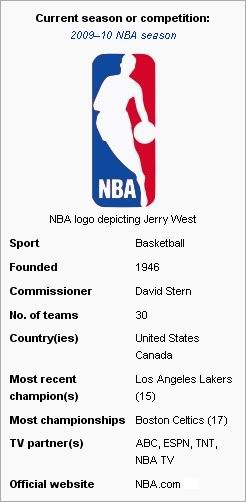
The National Basketball Association (NBA) is a professional basketball league, composed of thirty teams in North America (twenty-nine in the United States and one in Canada). It is an active member of USA Basketball (USAB), which is recognized by the International Basketball Federation as the National Governing Body (NGB) for basketball in the United States. The NBA is one of the four major North American professional sports leagues, which include Major League Baseball (MLB), the National Football League (NFL), and the National Hockey League (NHL).
The league was founded in New York City on June 6, 1946 as the Basketball Association of America (BAA). The league adopted the name National Basketball Association in 1949 after merging with the rival National Basketball League (NBL). The league's several international as well as individual team offices are directed out of its head offices located in the Olympic Tower at 645 Fifth Avenue in New York City. NBA Entertainment and NBA TV studios are directed out of offices located in Secaucus, New Jersey.
NBA Youtube Channel for their official videos Here.
NBA Coaches
There are currently 30 head coaches in the National Basketball Association (NBA).
Jerry Sloan has served as the head coach for the Utah Jazz since the 1988–89 NBA season, longer than any other current head coach. Sloan has also coached the most games (1591), won the most games (995), and lost the most games (596) among active coaches.
Los Angeles Lakers' head coach Phil Jackson has the highest winning percentage among the league's current coaches.
All active coaches are American, except for the Toronto Raptors' head coach, Jay Triano, who was born in Canada.
Popularity
Basketball's early adherents were dispatched to YMCAs throughout the United States, and it quickly
spread through the USA and Canada. By 1895, it was well established at several women's high schools.
While the YMCA was responsible for initially developing and spreading the game, within a decade it
discouraged the new sport, as rough play and rowdy crowds began to detract from the YMCA's primary mission.
However, other amateur sports clubs, colleges, and professional clubs quickly filled the void.
In the years before World War I, the Amateur Athletic Union and the Intercollegiate Athletic Association
of the United States (forerunner of the NCAA) vied for control over the rules for the game.
The first pro league, the National Basketball League, was formed in 1898 to protect players from exploitation
and to promote a less rough game. This league only lasted five years.
Public interviews and reviews coming soon.
spread through the USA and Canada. By 1895, it was well established at several women's high schools.
While the YMCA was responsible for initially developing and spreading the game, within a decade it
discouraged the new sport, as rough play and rowdy crowds began to detract from the YMCA's primary mission.
However, other amateur sports clubs, colleges, and professional clubs quickly filled the void.
In the years before World War I, the Amateur Athletic Union and the Intercollegiate Athletic Association
of the United States (forerunner of the NCAA) vied for control over the rules for the game.
The first pro league, the National Basketball League, was formed in 1898 to protect players from exploitation
and to promote a less rough game. This league only lasted five years.
Public interviews and reviews coming soon.
Equipments
The only essential equipment in a basketball game is the basketball and the court:
a flat, rectangular surface with baskets at opposite ends (or in the case of 3-on-3 street basketball, half a court with one basket).
Competitive levels require the use of more equipment such as clocks, scoresheets, scoreboard(s), alternating
possession arrows, and whistle-operated stop-clock systems.
An outdoor basketball net.
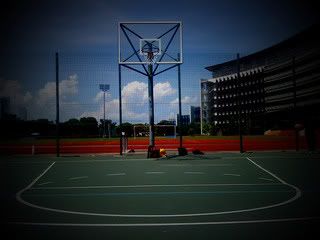
A regulation basketball court in international games is 28 by 15 meters (approx. 92 by 49 ft) and in the NBA
is 94 by 50 feet (29 by 15 m). Most courts are made of wood, usually maple. A steel basket with net and backboard hang over each end of the court. At almost all levels of competition, the top of the rim is exactly 10 feet (3.05 m) above the court and 4 feet (1.2 m) inside the baseline. While variation is possible in the dimensions of the court and backboard, it is considered important for the basket to be of the correct height; a rim that is off by but a few inches can have an adverse effect on shooting.
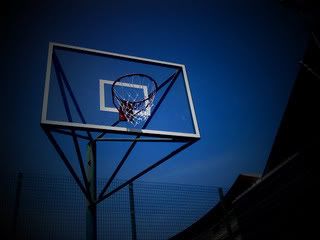
There are also regulations on the size a basketball should be.
If women are playing, the official basketball
size is 28.5" in circumference (size 6) and a weight of 20 oz.
For men, the official ball is 29.5" in circumference (size 7) and weighs 22 oz.
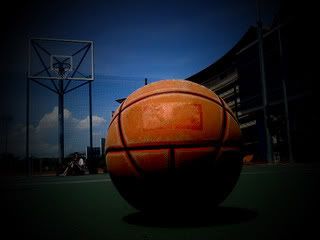
Development of equipment and technique
Basketball was originally played with a soccer ball. The first balls made specifically for basketball
were brown, and it was only in the late 1950s that Tony Hinkle, searching for a ball that would be more
visible to players and spectators alike, introduced the orange ball that is now in common use.
Dribbling was not part of the original game except for the "bounce pass" to teammates. Passing the ball
was the primary means of ball movement. Dribbling was eventually introduced but limited by the
asymmetric shape of early balls. Dribbling only became a major part of the game around the 1950s, as
manufacturing improved the ball shape.
a flat, rectangular surface with baskets at opposite ends (or in the case of 3-on-3 street basketball, half a court with one basket).
Competitive levels require the use of more equipment such as clocks, scoresheets, scoreboard(s), alternating
possession arrows, and whistle-operated stop-clock systems.
An outdoor basketball net.

A regulation basketball court in international games is 28 by 15 meters (approx. 92 by 49 ft) and in the NBA
is 94 by 50 feet (29 by 15 m). Most courts are made of wood, usually maple. A steel basket with net and backboard hang over each end of the court. At almost all levels of competition, the top of the rim is exactly 10 feet (3.05 m) above the court and 4 feet (1.2 m) inside the baseline. While variation is possible in the dimensions of the court and backboard, it is considered important for the basket to be of the correct height; a rim that is off by but a few inches can have an adverse effect on shooting.

There are also regulations on the size a basketball should be.
If women are playing, the official basketball
size is 28.5" in circumference (size 6) and a weight of 20 oz.
For men, the official ball is 29.5" in circumference (size 7) and weighs 22 oz.

Development of equipment and technique
Basketball was originally played with a soccer ball. The first balls made specifically for basketball
were brown, and it was only in the late 1950s that Tony Hinkle, searching for a ball that would be more
visible to players and spectators alike, introduced the orange ball that is now in common use.
Dribbling was not part of the original game except for the "bounce pass" to teammates. Passing the ball
was the primary means of ball movement. Dribbling was eventually introduced but limited by the
asymmetric shape of early balls. Dribbling only became a major part of the game around the 1950s, as
manufacturing improved the ball shape.
Rules, Court, and Game
In early December 1891, Dr. James Naismith, a Canadian-born physical education professor and instructor at
YMCA Training School(today, Springfield College) in Springfield, Massachusetts, USA, sought a vigorous indoor game
to keep his students occupied and at proper levels of fitness during the long New England winters. After rejecting
other ideas as either too rough or poorly suited to walled-in gymnasiums, he wrote the basic rules and nailed a
peach basket onto a 10-foot (3.05 m) elevated track. In contrast with modern basketball nets, this peach basket
retained its bottom, and balls had to be retrieved manually after each "basket" or point scored; this proved
inefficient, however, so a hole was drilled into the bottom of the basket, allowing the balls to be poked out
with a long dowel each time. The peach baskets were used until 1906 when they were finally replaced by metal
hoops with backboards. A further change was soon made, so the ball merely passed through, paving the way for
the game we know today. A soccer ball was used to shoot goals. Whenever a person got the ball in the basket, his
team would gain a point. Whichever team got the most points won the game. The baskets were originally nailed to
the mezzanine balcony of the playing court, but this proved impractical when spectators on the balcony began to
interfere with shots. The backboard was introduced to prevent this interference; it had the additional effect of
allowing rebound shots. Naismith's handwritten diaries, discovered by his granddaughter in early 2006, indicate
that he was nervous about the new game he had invented, which incorporated rules from a children's game called
"Duck on a Rock", as many had failed before it. Naismith called the new game "Basket Ball".
The first official game was played in the YMCA gymnasium on January 20, 1892 with nine players.
The game ended at 1-0; the shot was made from 25 feet (7.6 m), on a court just half the size of a present-day
Streetball or National Basketball Association (NBA) court. By 1897–1898 teams of five became standard.
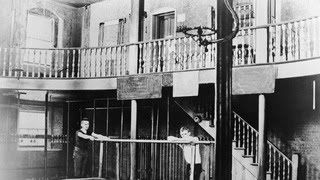
Canadian physician and teacher Dr. James Naismith (1861-1939) invented the game of basketball in 1891. Above, two boys stand on the first basketball court in the gymnasium of the School for Christian Workers, Springfield, Massachusetts, 1900s. (Hulton Archive/Getty Images)
YMCA Training School(today, Springfield College) in Springfield, Massachusetts, USA, sought a vigorous indoor game
to keep his students occupied and at proper levels of fitness during the long New England winters. After rejecting
other ideas as either too rough or poorly suited to walled-in gymnasiums, he wrote the basic rules and nailed a
peach basket onto a 10-foot (3.05 m) elevated track. In contrast with modern basketball nets, this peach basket
retained its bottom, and balls had to be retrieved manually after each "basket" or point scored; this proved
inefficient, however, so a hole was drilled into the bottom of the basket, allowing the balls to be poked out
with a long dowel each time. The peach baskets were used until 1906 when they were finally replaced by metal
hoops with backboards. A further change was soon made, so the ball merely passed through, paving the way for
the game we know today. A soccer ball was used to shoot goals. Whenever a person got the ball in the basket, his
team would gain a point. Whichever team got the most points won the game. The baskets were originally nailed to
the mezzanine balcony of the playing court, but this proved impractical when spectators on the balcony began to
interfere with shots. The backboard was introduced to prevent this interference; it had the additional effect of
allowing rebound shots. Naismith's handwritten diaries, discovered by his granddaughter in early 2006, indicate
that he was nervous about the new game he had invented, which incorporated rules from a children's game called
"Duck on a Rock", as many had failed before it. Naismith called the new game "Basket Ball".
The first official game was played in the YMCA gymnasium on January 20, 1892 with nine players.
The game ended at 1-0; the shot was made from 25 feet (7.6 m), on a court just half the size of a present-day
Streetball or National Basketball Association (NBA) court. By 1897–1898 teams of five became standard.

Canadian physician and teacher Dr. James Naismith (1861-1939) invented the game of basketball in 1891. Above, two boys stand on the first basketball court in the gymnasium of the School for Christian Workers, Springfield, Massachusetts, 1900s. (Hulton Archive/Getty Images)
Introduction
Basketball is a team sport in which two teams of five active players each try to score points against one another
by placing a ball through a 10 foot (3.048 m) high hoop (the goal) under organized rules.
Basketball is one of the most popular and widely viewed sports in the world.
Points are scored by throwing (shooting) the ball through the basket from above;
Team with more points at the end of the game wins.
The ball can be advanced on the court by bouncing it (dribbling) or passing it between teammates.
Disruptive physical contact (foul) is penalized and there are restrictions on how the ball can be handled (violations).
Through time, basketball has developed to involve common techniques of
shooting, passing and dribbling, as well as players' positions, and offensive and defensive structures.
Typically, the tallest members of a team will play center or one of two forward positions, while shorter players
or those who possess the best ball handling skills and speed, play the guard positions.
While competitive basketball is carefully regulated, numerous variations of basketball have developed for casual play.
In some countries, basketball is also a popular spectator sport.
While competitive basketball is primarily an indoor sport, played on a
basketball court, less regulated variations played in the outdoors have become
increasingly popular among both inner city and rural groups.
by placing a ball through a 10 foot (3.048 m) high hoop (the goal) under organized rules.
Basketball is one of the most popular and widely viewed sports in the world.
Points are scored by throwing (shooting) the ball through the basket from above;
Team with more points at the end of the game wins.
The ball can be advanced on the court by bouncing it (dribbling) or passing it between teammates.
Disruptive physical contact (foul) is penalized and there are restrictions on how the ball can be handled (violations).
Through time, basketball has developed to involve common techniques of
shooting, passing and dribbling, as well as players' positions, and offensive and defensive structures.
Typically, the tallest members of a team will play center or one of two forward positions, while shorter players
or those who possess the best ball handling skills and speed, play the guard positions.
While competitive basketball is carefully regulated, numerous variations of basketball have developed for casual play.
In some countries, basketball is also a popular spectator sport.
While competitive basketball is primarily an indoor sport, played on a
basketball court, less regulated variations played in the outdoors have become
increasingly popular among both inner city and rural groups.
Subscribe to:
Comments (Atom)

